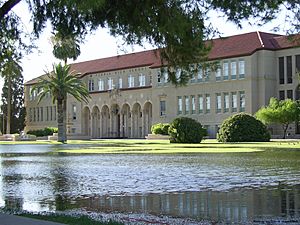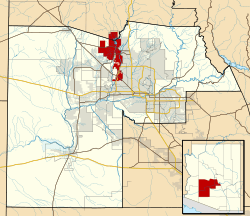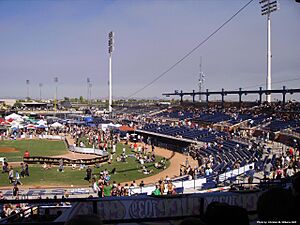Peoria, Arizona facts for kids
Quick facts for kids
Peoria, Arizona
|
|||
|---|---|---|---|

Peoria High School
|
|||
|
|||

Location in Maricopa County and Yavapai County, Arizona
|
|||
| Country | United States | ||
| State | Arizona | ||
| Counties | Maricopa, Yavapai | ||
| Named for | Peoria, Illinois | ||
| Government | |||
| • Type | Mayor-council government | ||
| Area | |||
| • Total | 179.25 sq mi (464.25 km2) | ||
| • Land | 176.08 sq mi (456.05 km2) | ||
| • Water | 3.17 sq mi (8.20 km2) | ||
| Elevation | 1,581 ft (482 m) | ||
| Population
(2020)
|
|||
| • Total | 190,985 | ||
| • Rank | US: 146th | ||
| • Density | 1,084.64/sq mi (418.78/km2) | ||
| Time zone | UTC−7 (MST (no DST)) | ||
| ZIP codes |
85345, 85373, 85380-85383, 85385
|
||
| Area code(s) | 623 and 928 | ||
| FIPS code | 04-54050 | ||
| GNIS feature ID | 2411401 | ||
Peoria is a city in Arizona, a state in the United States. Most of Peoria is in Maricopa County, but a small part is in Yavapai County. It's a big suburb of Phoenix.
In 2020, about 190,985 people lived in Peoria. This makes it the ninth-largest city in Arizona by population. It's also the sixth-largest in land area. The city was named after Peoria, Illinois, where many of its first settlers came from. The name "Peoria" comes from a Native American word meaning "prairie fire."
Peoria is famous for its spring training baseball. The San Diego Padres and Seattle Mariners baseball teams train here at the Peoria Sports Complex.
Contents
History of Peoria
How Peoria Started
Peoria is located in the Salt River Valley. It also reaches into the mountains to the north. A man named William John Murphy helped bring people to settle here. Many of these first settlers came from Peoria, Illinois.
The first family to live here was Albert J. and Elizabeth Straw in November 1886. Other families from Peoria, Illinois, soon followed them. An old desert road was the main way to travel until 1887. Then, a new road called Grand Avenue was built. This road went through new towns like Glendale and Peoria. It became the main route from Phoenix to the Vulture Mine.
The settlers officially named the town "Peoria" on May 24, 1897. They named it after their hometown in Illinois.
Early Days and Growth
The first map of Peoria had streets named after presidents, like Monroe and Washington. It also had streets named after trees, like Almond and Walnut. On August 4, 1888, Peoria got its own post office. About 27 people lived there at the time.
The first school district was set up in 1888. The first class was held in an empty brick store. Peoria's first school building was finished in 1891. It had just one room.
Between 1891 and 1895, a train track was built through Peoria. It connected Peoria to Phoenix and other towns. Peoria had a small train depot on 83rd Avenue. This old depot was later moved to McCormick-Stillman Railroad Park in Scottsdale.
Around 1919, the Peoria Chamber of Commerce was formed. This group acted like the town's government until Peoria officially became a city in 1954. The volunteer fire department started in 1920. It stayed all-volunteer until the mid-1950s.
New buildings were constructed, like the Edwards Hotel in 1918. The town's first newspaper, The Peoria Enterprise, was printed from 1917 to 1921. Peoria's first library opened in 1920 at the women's club. It later moved to the old City Hall.
Central School was built in 1906. By 1918, Peoria schools had 190 students. Before 1919, high school students had to go to Glendale. In 1919, Peoria High School was approved for construction.
Peoria Grows After the War
After World War II, more people moved to Peoria. This was because of a nearby air force base and the invention of air conditioning. Peoria started to become a suburb of Phoenix. It offered homes for people as Phoenix grew westward.
In 1954, Peoria had 1,925 residents. It officially became a city on June 7, 1954. A city council was formed to govern the new city. In 1956, Peoria was called the "Rose Capitol of the World."
By 1966, Peoria had grown to cover about 3.1 square miles. In 1968, the city built a sewer system. In 1970, Peoria started hiring paid firefighting staff instead of relying only on volunteers. The city's population grew quickly, from 4,792 in 1970 to 50,675 in 1990.
The city built a new municipal complex starting in 1988. This complex included the Police Department, City Hall, courts, and a new library.
Baseball spring training has a long history in Peoria. In the late 1970s, the Milwaukee Brewers used a small training facility here. In 1990, the city approved building the new Peoria Sports Complex. It opened in 1994. This was the first Major League Baseball spring training facility shared by two teams. The San Diego Padres and Seattle Mariners still use it today.
In 2005, the city started building the Peoria Center for the Performing Arts. This center opened in 2007. It became an important cultural spot for the area.
Peoria Today
Today, Peoria is known for its resorts and leisure activities. The city is working to create a "Desert Empire" along Loop 303. This area will have new industrial, commercial, and mixed developments.
For example, an Amkor semiconductor plant is being built in Peoria. This plant is expected to create about 2,000 new jobs. The city also opened Paloma Community Park on October 3, 2020. This park has fishing, sports fields, and picnic areas.
Geography and Climate
Peoria is located in northern Maricopa County. Its city limits also reach into Yavapai County. The city covers about 179.2 square miles. Most of this is land, but about 3.2 square miles is water. This water area comes from Lake Pleasant. Lake Pleasant is a reservoir on the Agua Fria River in the northern part of the city. Peoria added this area to its city limits in 1996.
The Agua Fria River and New River flow through Peoria. However, they are usually dry. This is because dams hold back their water for Lake Pleasant and for flood control. There are also many washes and creeks. Skunk Creek is important because it has trails and connects to Glendale.
Peoria has many mountains and hills in its northern part. Some of these include Sunrise Mountain, West Wing Mountain, and Cholla Mountain.
Peoria's Climate
Peoria has a hot desert climate. This means it has mild to warm winters and very hot summers.
| Climate data for Peoria, Arizona | |||||||||||||
|---|---|---|---|---|---|---|---|---|---|---|---|---|---|
| Month | Jan | Feb | Mar | Apr | May | Jun | Jul | Aug | Sep | Oct | Nov | Dec | Year |
| Record high °F (°C) | 87 (31) |
89 (32) |
98 (37) |
103 (39) |
113 (45) |
122 (50) |
122 (50) |
116 (47) |
114 (46) |
108 (42) |
95 (35) |
84 (29) |
122 (50) |
| Mean daily maximum °F (°C) | 68 (20) |
72 (22) |
78 (26) |
86 (30) |
95 (35) |
103 (39) |
104 (40) |
105 (41) |
100 (38) |
86 (30) |
76 (24) |
66 (19) |
87 (30) |
| Mean daily minimum °F (°C) | 42 (6) |
45 (7) |
50 (10) |
56 (13) |
65 (18) |
79 (26) |
80 (27) |
79 (26) |
73 (23) |
50 (10) |
48 (9) |
41 (5) |
59 (15) |
| Record low °F (°C) | 20 (−7) |
24 (−4) |
24 (−4) |
32 (0) |
27 (−3) |
51 (11) |
62 (17) |
54 (12) |
48 (9) |
35 (2) |
28 (−2) |
21 (−6) |
20 (−7) |
| Average precipitation inches (mm) | 1.04 (26) |
1.33 (34) |
1.07 (27) |
0.33 (8.4) |
0.10 (2.5) |
0.04 (1.0) |
0.92 (23) |
1.2 (30) |
0.82 (21) |
0.61 (15) |
0.68 (17) |
1.05 (27) |
9.19 (231.9) |
| Source: The Weather Channel | |||||||||||||
People of Peoria
Peoria's population has grown a lot over the years.
| Historical population | |||
|---|---|---|---|
| Census | Pop. | %± | |
| 1910 | 300 | — | |
| 1920 | 2,371 | 690.3% | |
| 1930 | 1,748 | −26.3% | |
| 1960 | 2,593 | — | |
| 1970 | 4,792 | 84.8% | |
| 1980 | 12,171 | 154.0% | |
| 1990 | 50,675 | 316.4% | |
| 2000 | 108,364 | 113.8% | |
| 2010 | 154,065 | 42.2% | |
| 2020 | 190,985 | 24.0% | |
| U.S. Decennial Census | |||
Here's a look at the different groups of people living in Peoria:
| Race / Ethnicity (NH = Non-Hispanic) | Pop 2000 | Pop 2010 | Pop 2020 | % 2000 | % 2010 | % 2020 |
|---|---|---|---|---|---|---|
| White alone (NH) | 84,370 | 111,242 | 126,300 | 77.86% | 72.20% | 66.13% |
| Black or African American alone (NH) | 2,887 | 4,904 | 7,028 | 2.66% | 3.18% | 3.68% |
| Native American or Alaska Native alone (NH) | 579 | 1,102 | 1,283 | 0.53% | 0.72% | 0.67% |
| Asian alone (NH) | 1,992 | 4,832 | 8,557 | 1.84% | 3.14% | 4.48% |
| Pacific Islander alone (NH) | 111 | 195 | 245 | 0.10% | 0.13% | 0.13% |
| Some Other Race alone (NH) | 108 | 212 | 767 | 0.10% | 0.14% | 0.40% |
| Mixed Race or Multi-Racial (NH) | 1,618 | 2,949 | 7,994 | 1.49% | 1.91% | 4.19% |
| Hispanic or Latino (any race) | 16,699 | 28,629 | 38,811 | 15.41% | 18.58% | 20.32% |
| Total | 108,364 | 154,065 | 190,985 | 100.00% | 100.00% | 100.00% |
In 2000, there were 108,364 people living in Peoria. There were 39,184 households, and 29,309 families. About 37.7% of households had children under 18. The average household had 2.73 people. The average family had 3.16 people.
The median age in the city was 36 years old. This means half the people were younger than 36, and half were older. The median income for a household was $52,199. For a family, it was $58,388.
Peoria's Economy
Peoria has many different businesses and employers. Here are some of the top employers in the city as of February 2017:
| # | Employer | # of Employees |
|---|---|---|
| 1 | Peoria Unified School District | 2,700 |
| 2 | City of Peoria | 1,150 |
| 3 | Walmart/Sam’s Club | 600 |
| 4 | Younger Brothers Companies Inc | 485 |
| 5 | The Antigua Group Inc | 340 |
| 6 | Immanuel Caring Ministries | 325 |
| 7 | Arizona Medical Clinic | 300 |
| 8 | OakCraft Inc | 300 |
| 9 | Freedom Plaza Peoria | 275 |
| 10 | Tyr Tactical | 200 |
Arts and Culture in Peoria
Peoria's Old Town has many historic buildings. The Peoria Center for the Performing Arts is located here. It opened in 2006 and is managed by Theater Works.
The city has also developed an entertainment area called "P83." This area is along 83rd Avenue between Bell Road and Thunderbird Road. It includes the Peoria Sports Complex, Arizona Broadway Theater, and Harkins Theatres. There are also many restaurants.
Peoria has public art displayed throughout the city. You can often see it in city parks and busy areas. The city also has a program where local artists and students create art for utility boxes.
The City of Peoria hosts several events each year. These include holiday events like an Easter Egg Hunt and a Halloween Bash. They also have "Second Saturday" events, which feature local artists, vendors, and musicians. "Somos Peoria" is a festival that celebrates Hispanic cultures.
Education in Peoria
Most of Peoria is part of the Peoria Unified School District (PUSD). However, some parts of the city are in other school districts. These include the Deer Valley Unified School District (DVUSD), Nadaburg Unified School District, and Wickenburg Unified School District.
PUSD has seven high schools. Four of them are located within Peoria city limits:
- Peoria – opened 1922
- Centennial – opened 1990
- Sunrise Mountain – opened 1996
- Liberty – opened 2006
The other three PUSD high schools are in Glendale:
- Cactus – opened 1977
- Ironwood – opened 1986
- Raymond S. Kellis – opened 2004
Peoria has many PUSD elementary schools. Some of these are Alta Loma, Apache, Copperwood, and Lake Pleasant. DVUSD schools within Peoria include Terramar and West Wing Elementary schools.
There are also many publicly funded charter high schools and elementary schools in Peoria. Cross of Glory Lutheran School is a Christian school for Pre-K through 8th grade. Huntington University also has a campus in Peoria. It focuses on digital media arts.
City Services and Transportation
Utilities
Peoria gets most of its water from the Central Arizona Project. This project uses a canal to bring water from the city's Lake Pleasant. Most of the city's electricity comes from Arizona Public Service. Some customers get electricity from the Salt River Project (SRP). The main sources of electricity are nuclear and coal power plants. Peoria has also invested a lot in solar power.
Roads and Freeways
Major roads and freeways in Peoria include:
- AZ-74
- Loop 303
- Loop 101
- US 60
A part of Northern Avenue in Peoria will become part of Northern Parkway between 2023 and 2026.
Airports
Pleasant Valley Airport is located within Peoria's city limits.
Notable People from Peoria
Many interesting people have connections to Peoria, including:
- Noah Beck, a social media personality
- Joshua Becker, a writer known for his minimalist lifestyle
- Dylan Cappello, a racing driver
- Jaff Decker, a professional baseball player
- Bryce Duke, a midfielder for CF Montréal in Major League Soccer
- Bob Howry, a former professional baseball pitcher
- Kyle Kosier, a former NFL football player for the Dallas Cowboys
- Matthew Liberatore, an MLB baseball pitcher for the St. Louis Cardinals
- Mary Peters, a former U.S. Secretary of Transportation
- Tim Toone, a former professional football player
- Kyle Bradish, an MLB baseball pitcher for the Baltimore Orioles
- Robert L. Fletcher, a citrus producer and entrepreneur
Sister Cities
Peoria has one sister city:
- Newtownards, County Down, Northern Ireland
See also
 In Spanish: Peoria (Arizona) para niños
In Spanish: Peoria (Arizona) para niños







